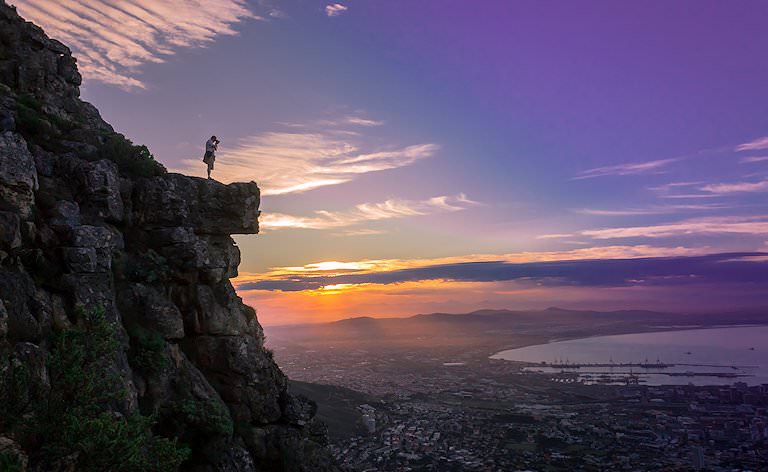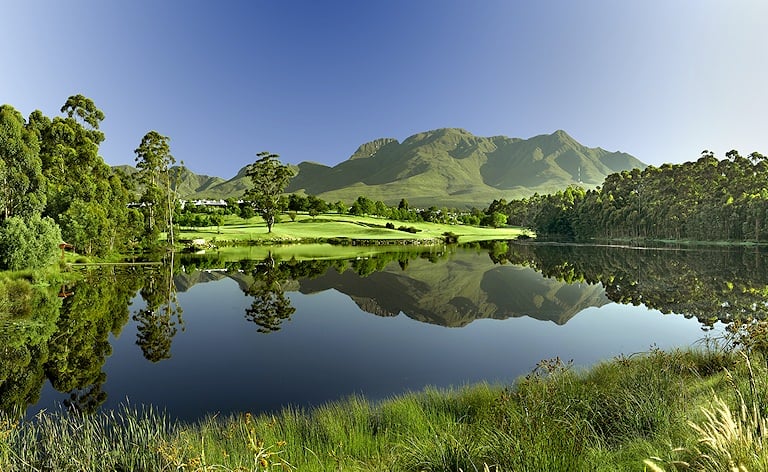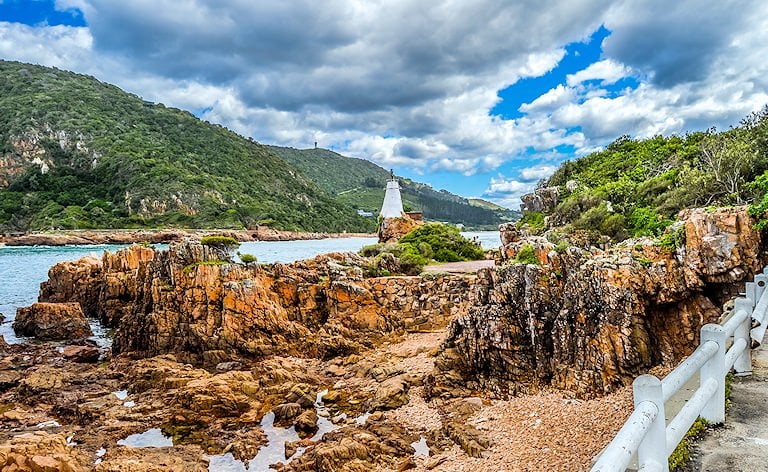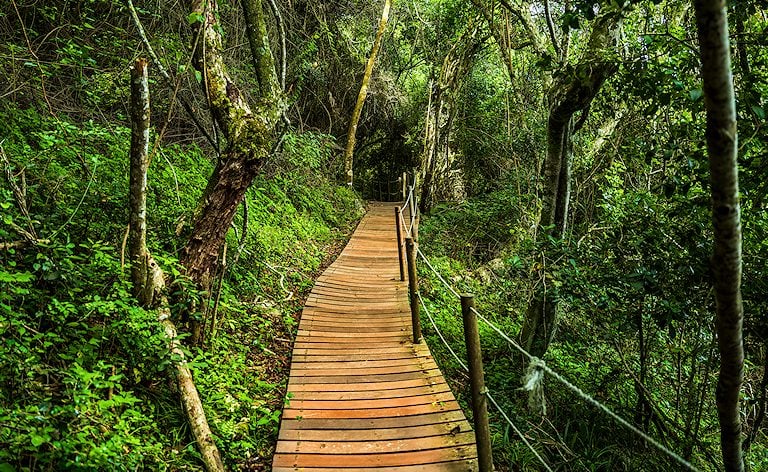Explore the Cape's finest attractions and play its best golf courses during a comprehensive green expedition.
Price Per Person Sharing From:
From: POAThe price can be reduced by substituting accommodations
What influences prices?

Upon arrival at Cape Town International Airport, guests are met by an African Sky guide and whisked off to the heights of Table Mountain via an exhilarating cable car ride. These rotating cars offer 360-degree views and climb 1067m above sea level in less than five minutes. The flat expanse of the summit provides well-demarcated pathways meandering through Indigenous fynbos and rocky outcrops favored by rock hyraxes (dassies). There is also a restaurant and gift shop. After enjoying the incredible views of the city, Table Bay, Robben Island, and the Cape Peninsula, we return to the base station, from where a short drive leads to the mountain's eastern slopes, where the Kirstenbosch Botanical Gardens stretch their indigenous verdure over 528 hectares.
These magnificent gardens were established in 1913 to preserve the region's unique flora. Enjoy a birds-eye view of the gardens from the 'Boomslang' Canopy Walkway before visiting various indoor and outdoor displays focusing on the diverse flora of South Africa, specifically highlighting the Cape Floral Kingdom. In the late afternoon, guests are assisted with check-in at their overnight accommodation.

Early this morning, we'll trace the False Bay coast toward Arabella Golf Course in Kleinmond. This coastal drive is one of the most scenic in the country, with various viewpoints from which to enjoy whale watching in season, from June to November. Southern right Whales journey up from the icy waters of the Southern Ocean to calve in the coves surrounding Walker Bay.
Arabella Golf Course enjoys an inimitable position on the Bot River Lagoon. The links-parkland combination course was designed by Peter Matkovich and is surrounded by striking natural scenery. Your round will be a challenging test, even for the good player, especially when the wind blows during the summer. The round ends with a par three, edging the lagoon, and a long curving par five following the shoreline, where a bunker is the only barrier preventing your golf ball from disappearing into the wetland.
Before returning to Cape Town, we visit the charming seaside town of Hermanus for a late lunch before taking a short hike along the cliff path to savor the views and spot marine life, including dolphins, seals, and whales, sometimes at very close quarters. Seeing these graceful mammals splashing about is a most rewarding experience. The tour returns to Cape Town in the late afternoon.

A drive over the spectacular Chapman's Peak pass, cut into the 650m high Chapman's Peak, leads the tour through the town of Noordhoek to the Cape of Good Hope Nature Reserve. A botanical and scenic delight, the reserve is home to several antelope species and a great diversity of flowering plants and birds. A highlight will surely be the walk to the edge of Cape Point, reached with the Flying Dutchman Funicular and the old lighthouse.
This Cape, which has played a central role in the tales and legends of the ocean, was and remains an important landmark at the South Western Edge of Africa. It was said that this was where the two halves of the world, east and west, met. The tour traces the ocean on the way back to Cape Town, stopping at Boulders Beach, an attractive secluded beach comprising a tumble of huge round rocks on a sandy shore, where the antics of a colony of mainland-based African penguins come under the spotlight. These critically endangered birds permanently nest here, using the boulders as a natural shield from the elements. A return journey to Cape Town follows this visit.

This morning, a short transfer to Steenberg follows breakfast. Designed by the renowned Peter Matkovich and opened in 1996, Steenberg is one of the most exclusive residential estates in the country. The course is predominantly parkland in design and feel and passes through four types of terrain: wetlands, parkland, Cape Flats, and fynbos, creating a unique golfing experience.
Wherever you find yourself on the course, the Constantiaberg Mountains provide a stunning backdrop to celebrated views of Cape Dutch buildings, oak avenues, vineyards, Indigenous bush, and mountain flora. Other pleasing features are the many elevated tee boxes set amongst the vineyards, creating great vantage points for the scenic setting. The course's 19th hole is luxurious but jolly, with an outside patio overlooking the green of the final hole, a par five guarded on the right by a water hazard. Upon completion of your round, some time is allotted to lunch before your guide will return you to the hotel in Cape Town.

Today, we travel from Cape Town to the Cape Winelands. The focus of the morning is playing Pearl Valley. A signature Jack Nicklaus design, his extensive use of bunkering and water make this a premier championship course that has already hosted two South African Opens. It was Nicklaus's second South African design, with the routing and shaping reflecting his creative abilities. Back tees can stretch the course to 6,801 meters (22,312 feet).
The nearby village of Franschhoek – 'French Corner' - owes its existence to a small group of French Huguenots who were settled here in the latter half of the 17th century and began working the Drakenstein Valley. Many settlers named their new farms after the areas in France from which they originated. La Motte, La Cotte, Cabriere, Provence, Chamonix, Dieu Donne, and La Dauphine were amongst the first established farms - most still retain their original buildings. If time allows, we'll visit the village and one of the fine wine farms in the region before check-in at the overnight accommodation.

The day is dedicated to exploring the irresistibly charming streets of Stellenbosch and enjoying wine tastings at a selection of nearby estates. Stellenbosch is the second-oldest settlement in South Africa and boasts beautiful examples of well-preserved Cape Dutch architecture. Rife with gourmet eateries, art galleries, boutiques, and historic finds, visitors may need help to depart.
We then visit Bergkelder for a unique cellar tour at a facility carved into the side of a mountain. The ambient temperature is immediately apparent as we enter the cellar, ensuring the wine is aged optimally. You will learn about the wine production process and have the opportunity to sample fine Fleur du Cap Wines. We then visit Boschendal or Lanzerac for another tasting before returning to our overnight accommodation. These grand estates feature impressive Cape Dutch manor houses in lush vineyards that produce various cultivars from which quality red and white wines are produced. Guests are returned to their overnight accommodations in the late afternoon.

After breakfast, we cross the imposing Franschhoek Pass and travel past the Theewaterskloof Dam to Robertson. In recent years, the wine industry in Robertson grew from less than twenty-five to more than fifty registered cellars. A number have received the highest awards, both locally and internationally. Notable cellars include Graham Beck, Springfield, Bon Cap, Majors Hill, and Excelsior Estate.
We'll stop at one of these fine estates. Later, we'll journey to Montagu, then Barrydale, Ladismith, and Calitzdorp before reaching South Africa's ostrich capital, Oudtshoorn. Once there, we'll cross the Outeniqua Mountains and travel to George. The nearby blue waters of the Indian Ocean are but a stone's throw away.

Today, we dedicate to playing the prestigious Fancourt Links. The fairways and tees are lined with cool-season grasses such as Kentucky Blue, Rye, and Fescue, while the greens are a dominant Bent. This Links-style course, the only one of its kind in the country, combines the surreal organic bloom of the environment with a rewarding play structure. Designed by the celebrated golfer and architect Gary Player, the Fancourt Links Golf Course is one of South Africa's most remarkable golf design and construction accomplishments.
The course hosted the President's Cup in 2003 and remains esteemed amongst amateur and professional golfers. In the afternoon, enjoy the natural spoils of the Fancourt Estate at leisure.

En route to Knysna, a scenic part of the Garden Route is traversed for a morning round at the Pezula Golf Course, with breathtaking views across the Indian Ocean. Perched on the Garden Route's cliff-capped coastline, the links-style Pezula's awe-inspiring position has been compared to California's Pebble Beach and Gleneagles in the Scottish Highlands.
Following your round at Pezula, the tour heads to the Knysna Quays, where we cross the Knysna Lagoon by ferry to the Featherbed Nature Reserve. Featherbed is a unique 150-ha private reserve that encompasses the entire western head of Knysna, offering sweeping views across the lagoon and the ocean as well as the treacherous passage between the two, which claimed many a ship during Knysna's days as an exporter of timber. The reserve is one of South Africa's heritage sites and is home to two of the Garden Route's natural icons: the Knysna Loerie and the blue duiker. Your visit includes an open 4x4 trip up the headland onto the reserve, stopping at spectacular viewpoints. A specialist guide will provide information on the area's history, fauna, and flora. After driving through the reserve to the top of the head, guests can take the optional 2.2 kilometers guided walk, passing through Milkwood forests onto the steep sandstone cliffs, into ancient Khoi Khoi sea caves, and along a scenic coastal path fringed with aromatic fynbos.

During the morning, guests play Fancourt Montagu. Originally developed by renowned South African golfer Gary Player, the Fancourt Montagu Golf Course recently underwent a handsome face-lift by Scottish golf course architect David McLay Kidd. The 1st and 9th holes were remodeled entirely, updating and enhancing the experience of this first-rate course.
The course is continually ranked amongst the top ten in South Africa. Montagu is considered one of the best-conditioned courses in the country. After a memorable golfing adventure, your round of golf is followed by a transfer to George Airport for a flight to Cape Town.
